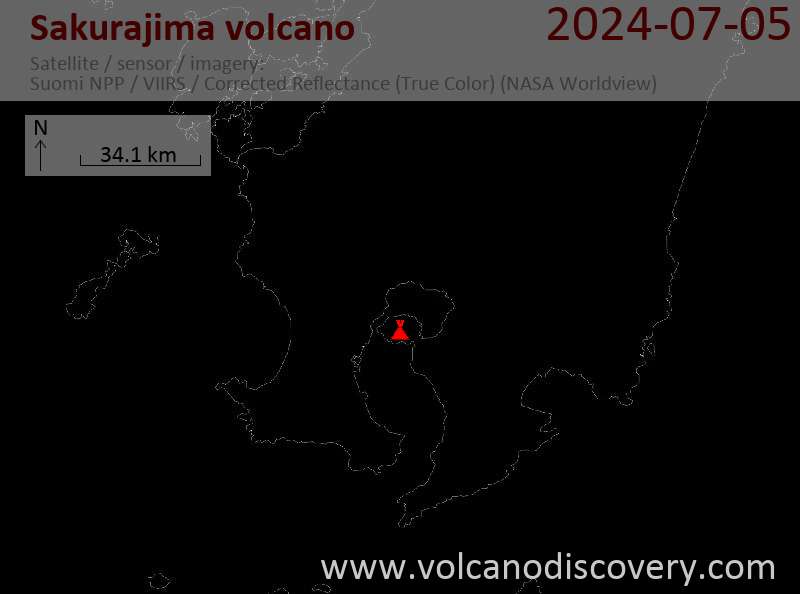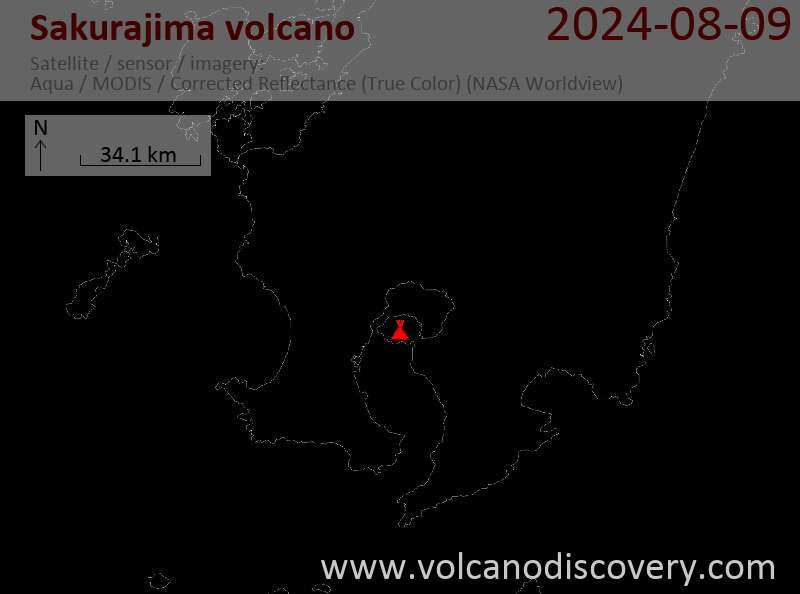Sakurajima Volcano
Sakurajima (also spelled Sakurashima or Sakura-jima, 桜島 in Japanese) volcano in southern Kyushu is one of the most active volcanoes in the world, and one of the few that are at present in constant (persistant) activity. Its ongoing typical activity range from strong strombolian to large ash explosions every 4-24 hours.
The volcano is the historically active center of the larger complex of the Aira caldera volcano. Located across Kagoshima Bay, which separates the city and the volcano by 4.2 km of water, its summit is only 8 km east of the city of Kagoshima with a population of half a million. Sakurajima's eruptive history has been recorded since the 8th century. It frequently deposits ash on Kagoshima. Due to its explosive potential, it is considered a very dangerous volcano and closely monitored.
The largest historical eruptions of Sakurajima took place during 1471-76 and in 1914.
Sakurajima volcano eruptions: 1955-ongoing, 1954(?), 1950, 1948, 1946, 1942, 1941, 1940, 1939, 1938, 1935, 1914-15, 1899(?), 1860, 1799, 1797, 1794, 1792, 1791, 1790, 1785, 1783, 1782, 1779-81, 1756, 1749, 1742, 1706, 1678, 1670(?), 1642, 1478, 1471-76, 1468, 778, 766, 764, 716-18, 712(?), 708
Latest nearby earthquakes
| Date and Time | Mag / Depth | Distance / Location | |||
|---|---|---|---|---|---|
| Aug 18, 08:42 pm (GMT +9) | 0.5 7.7 km | 28 km (17 mi) to the N | Info | ||
| Aug 18, 05:00 pm (GMT +9) | 0.6 0 km | 26 km (16 mi) to the SE | Info | ||
| Sunday, August 17, 2025 GMT (1 quake) | |||||
| Aug 18, 12:53 am (GMT +9) | 0.2 10.3 km | 21 km (13 mi) to the S | Info | ||
| Saturday, August 16, 2025 GMT (2 quakes) | |||||
| Aug 16, 06:58 pm (GMT +9) | 0.1 3.2 km | 27 km (17 mi) to the N | Info | ||
| Aug 16, 06:12 pm (GMT +9) | 0.4 69 km | 28 km (17 mi) to the SE | Info | ||
| Friday, August 15, 2025 GMT (1 quake) | |||||
| Aug 16, 01:23 am (GMT +9) | 1.6 10 km | 20 km (12 mi) to the NE | Info | ||
| Wednesday, August 13, 2025 GMT (1 quake) | |||||
| Aug 13, 05:18 pm (GMT +9) | 0.5 7.9 km | 26 km (16 mi) to the S | Info | ||
| Tuesday, August 12, 2025 GMT (1 quake) | |||||
| Aug 12, 05:12 pm (GMT +9) | 1.3 8.1 km | 24 km (15 mi) to the S | Info | ||
| Saturday, August 9, 2025 GMT (1 quake) | |||||
| Aug 10, 04:52 am (GMT +9) | 1.8 8.1 km | 24 km (15 mi) to the S | Info | ||
Background
Sakurajima's present day volcano is a new volcanic cone inside the 17 x 23 km wide Aira caldera forming the northern half of Kagoshima Bay. The caldera formed around 22,000 years ago during a Plinian eruption that produced large pyroclastic flows.Around 13,000 years ago, another smaller caldera, the so-called Wakamiko caldera was formed in the NE corner of the Aira caldera and was partially filled by volcanic cones. One of the new vents in this caldera eventually became present-day Sakura-jima located on the southern rim of Aira caldera. Sakurajima's early activity took place mainly at the Kita-dake summit cone until about 4850 years ago, after which its vent shifted to Minami-dake. The construction of Sakurajima formed a new island that was joined to the Osumi Peninsula during the major explosive and effusive eruption of 1914.
External link: Living in the Shade of Sakurajima—The Most Active Volcano in Japan (medium.com)
Sakurajima Volcano Photos




Significant volcanic eruptions: Sakurajima volcano
Additionally, there are 6 uncertain or discredited eruptions from Sakurajima volcano.
| Date | Note | VEI | Deaths | Damage | |
|---|---|---|---|---|---|
| Minamidake summit crater Historical obs./docs. | 2 | ||||
| Minami-dake and east flank (Showa crater) Historical obs./docs. | 3 | ||||
| 2013 Sep 4 (eruptive episode | Historical obs./docs. | 0 | light | Info | |
| 1974 Aug 9 (eruption | Historical obs./docs. | 3 | 5 | Info | |
| 1974 Jun 17 (eruption | Historical obs./docs. | 3 | 3 | Info | |
| 1955 Oct 13 (eruption | Historical obs./docs. | 3 | 1-50 (*) | Info | |
?? | Uncertain Eruption | 1? | |||
| Minami-dake Historical obs./docs. | 1 | ||||
| East flank of Minami-dake (750 m) Historical obs./docs. | 1 | ||||
| East flank of Minami-dake (750 m) Historical obs./docs. | 2 | ||||
| 1946 Jan (eruption | Historical obs./docs. | 2 | 1 | Info | |
| East flank of Minami-dake (750 m) Historical obs./docs. | 1 | ||||
| East flank of Minami-dake (750 m) Historical obs./docs. | 2 | ||||
| Minami-dake and east flank (750 m) Historical obs./docs. | 2 | ||||
| East flank of Minami-dake (750 m) Historical obs./docs. | 2 | ||||
| Minami-dake Historical obs./docs. | 2 | ||||
| Minami-dake Historical obs./docs. | 1 | ||||
| West, east and SE flanks Historical obs./docs. | 4 | ||||
| 1914 Jan 12 (eruption | Tsunami recorded Historical obs./docs. | 4 | 63 | heavy | Info |
?? | Uncertain Eruption | 1? | |||
| Minami-dake Historical obs./docs. | 1 | ||||
Eruptions of Sakurajima volcano
Moderate explosions with typical plume heights of around 2 km occured every 1-5 days during most of 2006-10. In 2009, a slight increase of activity was observed. Plume heights of explosions reached a maximum of 5 km altitude (4 km height). ...more info
On 4 June 2006, Sakurajima erupted from a small vent outside the summit crater, near or within the crater which erupted the 1946 (Showa) lava flow on the E slope of Minami-dake summit. The eruption continued intermittently until the next morning.
Sakurajima returned to low to medium levels of activity, with 150-200 eruptions per year. Occasional stronger explosions, such as on 7 October 2000, caused eruption columns as tall as 5 km above the crater, abundant ash falls, and damage windshields to cars.
Vigorous activity began in October 1999, marked by lava fountains and large large amounts of ejected ballistic bombs, blocks and lapilli falling as far as 4 km from the crater. ...more info
Compared to the 1980s, activity remained at lower levels at Sakurajima in the 1990, with explosions often occurring only at intervals of several days. Long pauses in explosive activity characterize the year 1995. ...more info
Explosions continue to occur typically one per day or two. Between 1985 and 1987, the activity produces particularly violent eruptions, peaking in November with 3 powerful explosions that cause much damage to cars and houses by impacting volcanic bombs. ...more info
Sarkurajima's activity was characterized by typically one explosion per day. THe largest eruptions produced plumes up to 4 km high, and on several occasions, landing aircraft at Kagoshima airport were damaged when flying through ash.
The eruptions caused no fatalities, but damaged cars, windows and crops in the immediate area around the volcano. ...more info
Sakurajima Volcano FAQ
+When was the last eruption of Sakurajima volcano?
The last confirmed eruption of Sakurajima began in 2017 and is continuing (as of August 2025).
+How often does Sakurajima volcano erupt?
Since 708 AD, Sakurajima volcano has had at least 36 historically documented eruptions. This means that it erupts on average every 36.6 years.
Many eruptions of Sakurajima have lasted more than one year. In total, the volcano has been in eruption during 115 out of 1317 years until now. In other words, Sakurajima has been active at least one in 11.5 years on average. Note that this value is likely an underestimate, because the known history of eruptions from Sakurajima is likely incomplete, especially further back in time.
+How active is Sakurajima volcano at present?
Sakurajima volcano is extremely active: Since 1900, it has been frequently active, showing eruptive activity during 82 years out of 126 as of now. The latest eruption is still continuing at present.
+When was the largest eruption of Sakurajima volcano?
The largest eruption known from the younger geological history of Sakurajima volcano occurred around 8050 BC. It ranks as a plinian eruption with a magnitude 5 on the VEI (Volcanic Explosivity Index) scale. Eruption of this size are often catastrophic on a regional scale.
Latest satellite images
Price on request
Sakurajima Volcano Maps












































